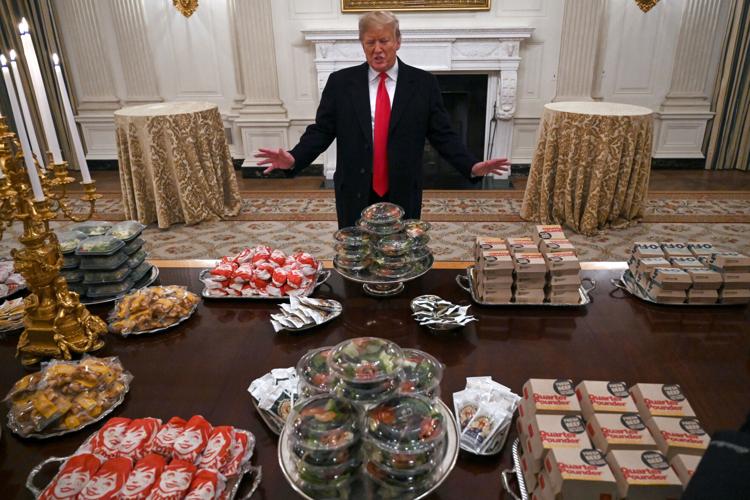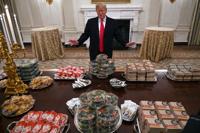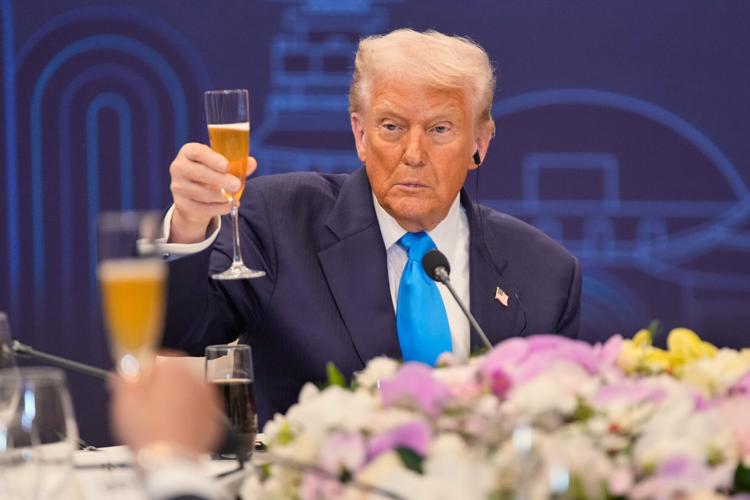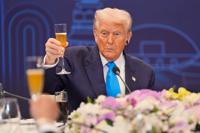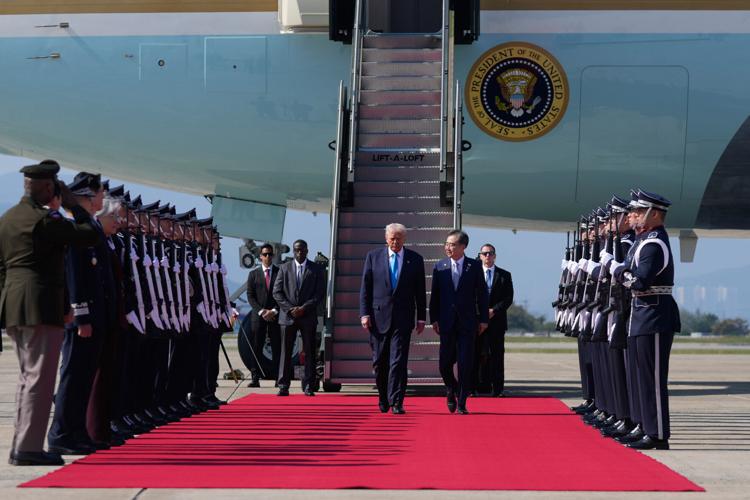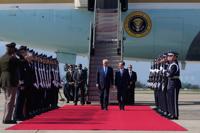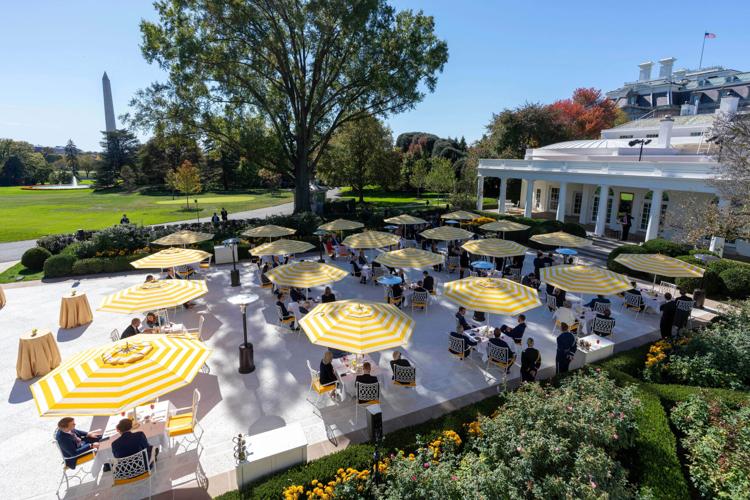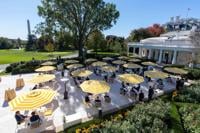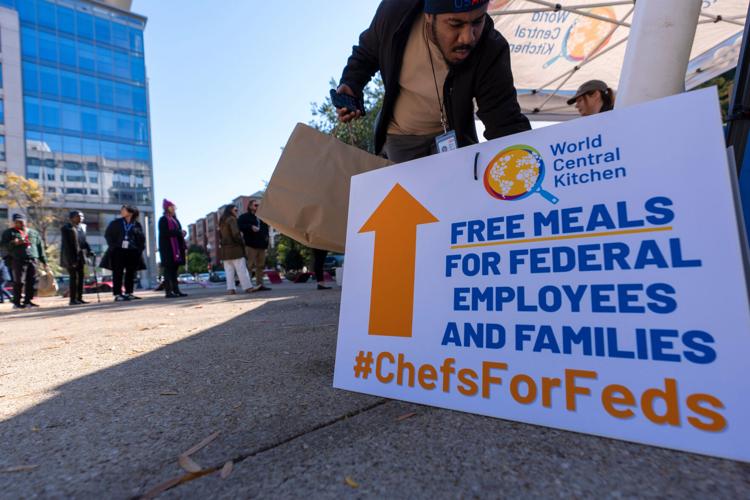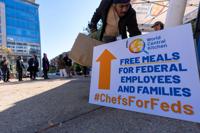WASHINGTON (AP) — President Donald Trump isn't curtailing travel. He's not avoiding golf or making do with a skeleton staff in the West Wing. Even hamburgers served at the White House aren't from McDonalds, this time.
In shutdowns past — including during Trump's first term — presidents normally scaled back their schedules. With staffers deemed “non-essential” sent home, the White House often sought to appear sympathetic to Americans affected by disruptions to health care, veterans benefits and other key services.
The current shutdown has left around 750,000 federal employees furloughed and others working without pay. Funding for the Supplemental Nutrition Assistance Program, or SNAP, is lapsing after Friday — affecting 1 in 8 Americans who rely it to help buy groceries.
Nonetheless, it's been mostly business as usual for Trump over the past 29 days.
“It’s like that country song: ‘Sometimes falling feels like flying for a little while,’" said Paul Begala, a Democratic strategist and former adviser to President Bill Clinton, who presided over two shutdowns between 1995 and 1996. "They seem to be like, ‘So far, so good, man.’”
Ballroom building, golf, fundraisers and trips
Trump is on a six-day swing through Asia, after a recent, whirlwind Middle East visit to celebrate a U.S.-brokered ceasefire deal in Israel’s war with Hamas in Gaza. He hosted a White House fundraiser for major donors to his $300 million ballroom that has seen construction crews tear down the East Wing, and held another fundraiser at his Mar-a-Lago estate in Florida.
Members of the Cabinet have similarly hit the road. Vice President JD Vance traveled to Israel, Homeland Security Secretary Kristi Noem went to Portland, Oregon, to decry protests there, and Defense Secretary Pete Hegseth got a firsthand look at TOPGUN, the U.S. Navy’s elite fighter weapons school in Nevada.
Only 32% of the staff in the Executive Office of the President were set to be furloughed during the current shutdown, according to data in a contingency report from the White House budget office. That's down from 61% during the last shutdown in 2018-19, during Trump's first term. About half of the Executive Mansion's team of housekeepers, ushers, valets and butlers are currently working. Last time, more than 70% were furloughed.
It’s often been hard to tell a shutdown is happening with so many staffers remaining at their desks.
“I don’t even know if they’re supposed to be working, but they wouldn’t miss a day,” Trump said during an event last week.
It's a departure from Trump's first term, when he cut out weekend golf games and canceled a planned trip to Mar-a-Lago for Christmas during the 2018 shutdown, which stretched into the new year. He made a surprise visit to visit troops in Iraq then, but nixed plans to go to the Swiss alps for the World Economic Forum.
When hosting Clemson University football players to celebrate their NCAA football championship, Trump brought in burgers and fries from McDonald’s, Burger King and Wendy's and pizza from Domino's because of White House staff furloughs.
This time, the president had Republican senators over for a lunch that featured burgers, too. But staff made them. “They do great food at the White House,” Trump said.
‘A smarter approach’
Barreling ahead like there's no shutdown has some political advantages for Trump, allies say: It allows him to look presidential while avoiding congressional bickering.
“It’s a much smarter approach,” said Marc Short, chief of staff to former Vice President Mike Pence.
In Trump's first-term shutdown, he rejected a congressional compromise to force the government to close — an attempt to win funding for a wall along the U.S.-Mexico border. Then, he named Pence as lead negotiator to end the shutdown while involving his son-in-law Jared Kushner — creating the visual of the pair having to go to Capitol Hill.
“The first go-around, he was pretty clear with cameras rolling: He said he wanted the shutdown. He claimed ownership,” Short said. This time? “The White House has been clear about not owning it.”
Back in 1995, Begala recalled talking strategy with Clinton during a sweaty summer run at Fort McNair in Washington, and telling the president that Republican House Speaker Newt Gingrich and his party “think they can roll you” to make cuts to Medicare by threatening a shutdown.
Clinton responded: “‘My favorite movie’s ‘High Noon,’” Begala recalled, referring to the 1952 Western in which a marshal stands up to outlaws. ”‘They do that -- then I just have a Gary Cooper, High Noon moment. That’s easy.’”
When Gingrich later came to the White House to negotiate, Begala said Clinton refused to budge, even though some advisers urged him to cut a deal. Voters ultimately blamed congressional Republicans more than the White House for the government closing, and Clinton was easily reelected in 1996.
“That could have really gone badly for Clinton," Begala said. “But he did understand that standing strong and having a Gary Cooper moment would be really good for him.”
Past White Houses highlighted shutdown effects
During the 16-day government shutdown of 2013, President Barack Obama scrapped a four-country Asia trip and skipped the swanky Congressional Hispanic Caucus gala. His schedule featured events meant to show the effects of the shutdown, including visiting a Maryland construction firm that benefited from the kind of federal business loans being jeopardized with the government shuttered.
In 2019, as that shutdown dragged on, Trump's White House officials acknowledged feeling pressure to end it, worried that Trump's polling numbers could suffer. This time, the administration's public messaging has been to blame the Democrats while signaling that it's prepared to wait — even warning of coming travel delays during the Thanksgiving holidays.
“President Trump is continuing to work night and day on behalf of American people," White House spokesperson Abigail Jackson said in a statement. “The entire administration, including the president, will continue highlighting the workers and families who are suffering because of the Democrats’ decision to shut down the government.”
Bill Daley, a White House chief of staff to Obama in the years prior to the 2013 shutdown, said Trump isn't acting like he's feeling political heat to reopen the government, even before next Tuesday's gubernatorial elections in Virginia and New Jersey — both home to sizable federal workforces.
“My guess is, he thinks it helps him," Daley said, “until — and I don't know if it will — the bottom falls out.”
Democrats are demanding an extension of expiring tax credits that have helped millions of people afford health insurance, while Republicans have refused to negotiate until the government is reopened.
Trump has said the government must reopen, but also used the shutdown to cut federal positions and target programs Democrats favor, while redirecting funds to his own priorities — like covering military paychecks. The president has even said of closed museums, “We should probably just open them,” though that hasn’t yet happened.
Americans, meanwhile, are divided on who's to blame.
Roughly 6 in 10 say Trump and congressional Republicans have “a great deal” or “quite a bit” of responsibility for the shutdown, while 54% say the same about Democrats in Congress, according to a recent poll from The Associated Press-NORC Center for Public Affairs Research.
Mike McCurry, a White House press secretary under Clinton, said Democrats have yet to settle on a clear shutdown message that has resonated. Trump has the presidency to deliver his take, but McCurry noted he has been “mercurial.”
“It is not likely we’re going to have clear winners or losers after this," McCurry said. “It’s going to be a bit of a muddle.”


